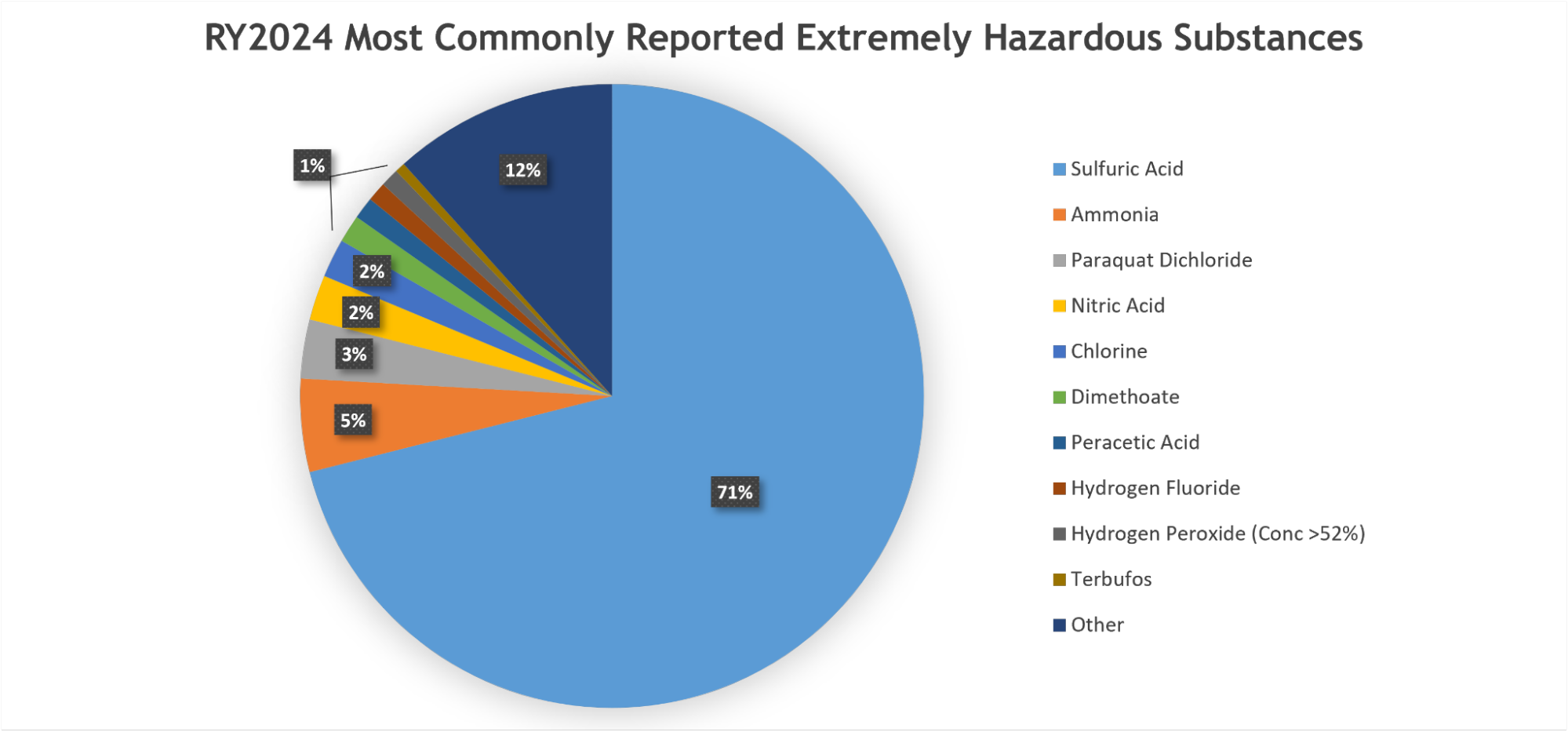Tier II data
Tier II reports track chemicals stored at a facility during the previous calendar year that exceeded thresholds set by the Environmental Protection Agency (EPA). Tier II reports include data about the types and quantities of chemicals stored at a facility. Tier II reporting does not apply to consumer products used for personal, family, or household purposes. For example, batteries for Tier II reporting purposes are the large batteries used for heavy machinery and equipment.
CDPHE provides this data to emergency planners and first responders. Reported information provides valuable information for emergency planners, such as the facility’s location, names and approximate quantities of stored chemicals, and emergency contact information.
Tier II reports do not represent any violations or wrongdoing on the part of the business nor does it relate to the release or discharge of hazardous chemicals. Storage of a chemical requiring a Tier II report does not mean that these chemicals are impacting the environment or public health. For more information on how hazardous chemicals are regulated and controlled, please visit CDPHE’s Hazardous Materials and Waste Management Website.
Reporting Year 2024 Summary
Facilities submit Tier II reports annually by March 1st of each year for chemicals stored in the previous year. For Reporting Year (RY) 2024, Colorado received Tier II reports from 11,286 facilities. These facilities represent a wide range of industries, including common businesses like gas stations, hardware and retail stores, and concrete/asphalt plants. In total, Tier II reports were submitted from over 300 industry sectors. Although many facilities file Tier II reports, the overwhelming majority (90%) of facilities store three or fewer chemicals on-site. These chemicals can include substances seen every day, such as gasoline, propane, cleaning solvents, and diesel. Fees collected from Tier II reporting fund pollution prevention support for businesses across the state.

Most commonly reported chemicals
The table (on right) displays the most commonly reported chemicals for RY 2024. The table outlines the chemical name and some of its common uses or applications. Chemicals are listed from largest to smallest of total quantity reported.
Oil and gas production made up the largest quantity of reported chemicals under Tier II. Produced water is a byproduct created from the drilling process of oil and natural gas wells. Crude oil and condensate from those oil and natural gas wells are mixtures of hydrocarbons that have not been processed into refined oil. Oil and gas facilities are required to follow rules and regulations related to the storage and disposal of these and other hazardous chemicals.
| Chemical Name | Common Uses and Applications |
|---|---|
| Produced Water | Oil and gas production |
| Crude Oil | Oil and gas production |
| Oil and Gas Condensate | Oil and gas production |
| Diesel | Engines and generators |
| Oils and Lubricants | Engine/motor oil and lubricants |
| Liquid Petroleum Gas | Fuel for heating appliances, cooking equipment, and vehicles |
| Ethylene Glycol | Antifreeze, brake fluid, paint, and solvents |
| Sodium Hydroxide | Soaps, paper, textiles, detergents, and petroleum products |
| Gasoline | Vehicle and small engines |
| Lead | Batteries, ammunition, cable sheathing, and protective shielding |
For more information on oil and gas regulations and compliance, please see the Air Quality Control Division’s Oil and Gas Compliance Website.
Extremely hazardous substances
Extremely hazardous substances (EHSs) are chemicals that can cause serious irreversible health effects from accidental releases. The EPA is responsible for managing the list of EHSs and setting the chemicals’ reporting thresholds. For more information on the EPA EHS lists, visit: the EPA’s List of Extremely Hazardous Substances and Their Threshold Planning Quantities Appendix A.
The most commonly reported EHSs in Colorado for RY2024 are displayed below.

The “Other” category is composed of 350 unique chemicals that each make up less than 1% of the total EHSs reported.
Sulfuric acid was the most common EHS for Reporting Year 2024, making up 71% of all EHSs reported in Colorado. The majority of facilities that filed reports for sulfuric acid linked its use to the storage of lead-acid batteries. Lead-acid batteries are the most prevalent type of commercially available rechargeable battery. These batteries use an electrolyte typically consisting of a mixture of sulfuric acid and water. Since sulfuric acid is an EHS, proper use and storage of lead-acid batteries are essential.
Tier II data questions
Local Emergency Planning Committees (LEPCs)
Each county in Colorado has an LEPC that develops emergency response plans and provides information about chemicals in its county to citizens.
To find your county’s LEPC, please visit the Division of Homeland Security and Emergency Management web page.
Tier II Data Requests
For public data requests of Tier II reports, email cdphe.ppsaratitle3@state.co.us.
Please note that requests must contain a specific facility name and address. CDPHE can only fulfill bulk data requests for the State Emergency Response Commission, Local Emergency Planning Committees, and fire departments.
Colorado Emergency Planning Commission (CEPC)
The CEPC is Colorado’s appointed State Emergency Response Commission. The CEPC is responsible for implementing the Emergency Planning and Community-Right-to-Know-Act in Colorado.
Visit the CEPC’s webpage for more information.
If you have CEPC questions, contact:
Tim Gablehouse
tgablehouse@gcgllc.com
Roy Rudisill
rrudisill@weld.gov
Learn More About the Management of Hazardous Substances
For more information on how hazardous chemicals are managed and regulated, visit CDPHE’s Hazardous Materials and Waste Management Website.
You can also contact the customer technical assistance hotline:
303-692-3320
comments.hmwmd@state.co.us
Sign up for HMWMD email alerts / Regístrate para recibir alertas por correo electrónic